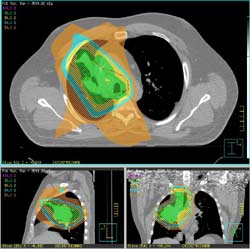What is 3D Conformal Radiation Therapy (CRT)?

3D CRT is a cancer treatment that allows doctors to direct radiation beams to conform to tumor shapes.
In the past, beams only matched the height and width of the tumor — and exposed healthy tissue to radiation.
Advances in imaging technology now let doctors find and treat the tumor in a more precise way.
CRT uses targeting data to focus right on the tumor and avoid the healthy tissue around it. This exact targeting allows for higher levels of radiation in treatment, which is better for shrinking and killing tumors.
3D CRT is — in many ways — like intensity-modulated radiation therapy (IMRT). They both target cancer while sparing healthy tissue.
Your radiation doctor will decide which treatment is best for you, based on your tumor's shape and where it is.
How Do You Deliver 3D Conformal Radiation Therapy?
Before treatment, you'll have a 3D CRT planning session, where your doctor will make a mold to custom fit you.
They'll take a 3D image of your tumor with methods like:
- CT scan.
- MRI.
- PET scan.
- PET-CT scan.
Then, a computer program studies the 3D image and designs radiation beams that match the shape of the tumor.
Contact Us About Radiation Oncology at UPMC Hillman Cancer Center
To learn more about radiation treatments or to make an appointment you can:
- Call 412-647-2811
- Contact a UPMC Hillman Cancer Center near you.
A 3D CRT session takes about 30 minutes.
The doctor sets up the treatment based on the 3D images of the tumor and the info from the planning session.
These are the steps:
- You lie in the mold on the x-ray table.
- During treatment, beams from many directions precisely match the tumor's height, width, and depth.
- The linear accelerator moves in a circular fashion around the tumor area.
- The actual treatment lasts only a few minutes.
Your cancer doctor will decide your treatment plan, including how many times a week you'll need to repeat 3D CRT.
3D CRT cancer treatment:
- Sends more precise radiation beams to cancer cells than 2D radiation. Because it's so precise, doctors can give the highest dose of radiation to the tumor. More radiation can shrink tumors more effectively.
- Lessens the amount of radiation to healthy tissue around the tumor. This spares as much normal tissue as possible.
Because 3D CRT takes place over a few sessions, any affected normal tissue has time to heal.
Many types of cancer have seen improved outcomes from 3D CRT, including:
Because 3D CRT is precise and doesn't damage much healthy tissue, some people don't have any side effects.
When people do have side effects, doctors can often manage them with drugs. Most side effects are short-term and go away within a month to six weeks after your last treatment.
Side effects from 3D CRT depend on what part of your body the doctors treated and may include:
- Fatigue.
- Sore throat.
- Loss of appetite.
- Changes in taste.
- Nausea.
- Heartburn.
- Hair loss.
- Sore skin in the treatment area.
- Trouble swallowing.
- Lung problems.
 UPMC
UPMC
 UPMC Children's Hospital of Pittsburgh
UPMC Children's Hospital of Pittsburgh
 UPMC Magee-Womens Hospital
UPMC Magee-Womens Hospital

